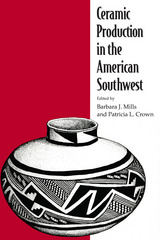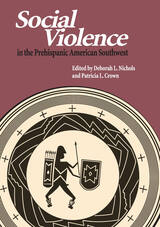2 books by Crown, Patricia L.

Ceramic Production in the American Southwest
Edited by Barbara J. Mills and Patricia L. Crown
University of Arizona Press, 1995
Southwestern ceramics have always been admired for their variety and aesthetic beauty. Although ceramics are most often used for placing the peoples who produced them in time, they can also provide important clues to past economic organization. This volume covers nearly 1000 years of southwestern prehistory and history, focusing on ceramic production in a number of environmental and economic contexts. It brings together the best of current research to illustrate the variation in the organization of production evident in this single geographic area. The contributors use diverse research methods in their studies of vessel form and decoration. All support the conclusion that the specialized production of ceramics for exchange beyond the household was widespread. The first seven chapters focus on ceramic production in specific regions, followed by three essays that re-examine basic concepts and offer new perspectives. Because previous studies of southwestern ceramics have focused more on distribution than production, Ceramic Production in the American Southwest fills a long-felt need for scholars in that region and offers a broad-based perspective unique in the literature. The Southwest lacked high levels of sociopolitical complexity and economic differentiation, making this volume of special interest to scholars working in similar contexts and to those interested in craft production.
[more]

Social Violence in the Prehispanic American Southwest
Edited by Deborah L. Nichols and Patricia L. Crown
University of Arizona Press, 2008
Spontaneous acts of violence born of human emotions like anger or greed are probably universal, but social violence—violence resulting from social relationships within and between groups of people—is a much more complex issue with implications beyond archaeology. Recent research has generated multiple interpretations about the forms, intensity, and underlying causes of social violence in the ancient Southwest. Deborah L. Nichols and Patricia L. Crown have gathered nine contributions from a variety of disciplines to examine social violence in the prehispanic American Southwest. Not only offering specific case studies but also delving into theoretical aspects, this volume looks at archaeological interpretations, multidisciplinary approaches, and the implications of archaeological research for Native peoples and how they are impacted by what archaeologists say about their past. Specific chapters address the impacts of raiding and warfare, the possible origins of ritual violence, the evidence for social violence manifested in human skeletal remains, the implications of witchcraft persecution, and an examination of the reasons behind apparent anthropophagy. There is little question that social violence occurred in the American Southwest. These contributions support the need for further discussion and investigation into its causes and the broader implications for archaeology and anthropology.
CONTENTS
1. Introduction
Patricia Crown and Deborah Nichols
2. Dismembering the Trope: Imagining Cannibalism in the Ancient Pueblo World
Randall H. McGuire and Ruth Van Dyke
3. An Outbreak of Violence and Raiding in the Central Mesa Verde Region in the 12th Century AD
Brian R. Billman
4. Chaco Horrificus?
Wendy Bustard
5. Inscribed in the Body, Written in Bones: The Consequences of Social Violence at La Plata
Debra L. Martin, Nancy Akins, Bradley Crenshaw, and Pamela K. Stone
6. Veneration or Violence: A Study of Variations in Patterns of Human Bone Modification at La Quemada
Ventura R. Pérez, Ben A. Nelson, and Debra L. Martin
7. Witches, Practice, and the Context of Pueblo Cannibalism
William H. Walker
8. Explanation vs. Sensation: The Discourse of Cannibalism at Awat’ovi
Peter Whiteley
9. Devouring Ourselves
George J. Armelagos
References Cited
About the Contributors
Index
CONTENTS
1. Introduction
Patricia Crown and Deborah Nichols
2. Dismembering the Trope: Imagining Cannibalism in the Ancient Pueblo World
Randall H. McGuire and Ruth Van Dyke
3. An Outbreak of Violence and Raiding in the Central Mesa Verde Region in the 12th Century AD
Brian R. Billman
4. Chaco Horrificus?
Wendy Bustard
5. Inscribed in the Body, Written in Bones: The Consequences of Social Violence at La Plata
Debra L. Martin, Nancy Akins, Bradley Crenshaw, and Pamela K. Stone
6. Veneration or Violence: A Study of Variations in Patterns of Human Bone Modification at La Quemada
Ventura R. Pérez, Ben A. Nelson, and Debra L. Martin
7. Witches, Practice, and the Context of Pueblo Cannibalism
William H. Walker
8. Explanation vs. Sensation: The Discourse of Cannibalism at Awat’ovi
Peter Whiteley
9. Devouring Ourselves
George J. Armelagos
References Cited
About the Contributors
Index
[more]
READERS
Browse our collection.
PUBLISHERS
See BiblioVault's publisher services.
STUDENT SERVICES
Files for college accessibility offices.
UChicago Accessibility Resources
home | accessibility | search | about | contact us
BiblioVault ® 2001 - 2024
The University of Chicago Press









